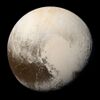Astronomy:(26375) 1999 DE9
From HandWiki
| Discovery | |
|---|---|
| Discovered by | Chadwick A. Trujillo and Jane X. Luu |
| Discovery date | 20 February 1999 |
| Designations | |
| (26375) 1999 DE9 | |
| Minor planet category | TNO 2:5 resonance[1] |
| Orbital characteristics[2] | |
| Epoch 13 January 2016 (JD 2457400.5) | |
| Uncertainty parameter 2 | |
| Observation arc | 6619 days (18.12 yr) |
| |{{{apsis}}}|helion}} | 79.663 astronomical unit|AU (11.9174 Tm) |
| |{{{apsis}}}|helion}} | 32.342 AU (4.8383 Tm) |
| 56.002 AU (8.3778 Tm) | |
| Eccentricity | 0.42249 |
| Orbital period | 419.10 yr (153075 d) |
| Average Orbital speed | 3.81 km/s |
| Mean anomaly | 25.385° |
| Mean motion | 0° 0m 8.466s / day |
| Inclination | 7.6076° |
| Longitude of ascending node | 322.909° |
| 160.236° | |
| Earth MOID | 31.3582 AU (4.69112 Tm) |
| Jupiter MOID | 27.062 AU (4.0484 Tm) |
| Physical characteristics | |
| Dimensions | 461 ± 45 km[3] |
| Rotation period | 24 h (1.0 d) |
| Geometric albedo | 0.06–0.08[3] |
| Physics | ≈37 K |
| Absolute magnitude (H) | 5.0 |
(26375) 1999 DE9 (provisional designation 1999 DE9) is a trans-Neptunian object. Light-curve-amplitude analysis shows only small deviations, suggesting (26375) 1999 DE9 is a spheroid with small albedo spots.[4] Measurements by the Spitzer Space Telescope estimate that it is 461 ± 45 km in diameter.[3] It was discovered in 1999 by Chad Trujillo and Jane X. Luu. It is possibly a dwarf planet.[5]
(26375) 1999 DE9 orbit is in 2:5 resonance with Neptune's.[1] Spectral analysis has shown traces of ice.[6]
References
- ↑ 1.0 1.1 Marc W. Buie (2008-03-14). "Orbit Fit and Astrometric record for 26375". SwRI (Space Science Department). http://www.boulder.swri.edu/~buie/kbo/astrom/26375.html. Retrieved 2008-09-24.
- ↑ "JPL Small-Body Database Browser: 26375 (1999 DE9)". NASA/Jet Propulsion Laboratory. https://ssd.jpl.nasa.gov/sbdb.cgi?sstr=26375;cad=1.
- ↑ 3.0 3.1 3.2 Stansberry, Grundy, Brown, Spencer, Trilling, Cruikshank, Luc Margot Physical Properties of Kuiper Belt and Centaur Objects: Constraints from Spitzer Space Telescope (2007) arXiv:astro-ph/0702538
- ↑ Tancredi, G., & Favre, S. (2008) Which are the dwarfs in the Solar System?. Depto. Astronomía, Fac. Ciencias, Montevideo, Uruguay; Observatorio Astronómico Los Molinos, MEC, Uruguay. Retrieved August 10, 2011
- ↑ Icy Dwarf Planets and TNOs
- ↑ Fig 3 for 1999 DE9
External links
 |



